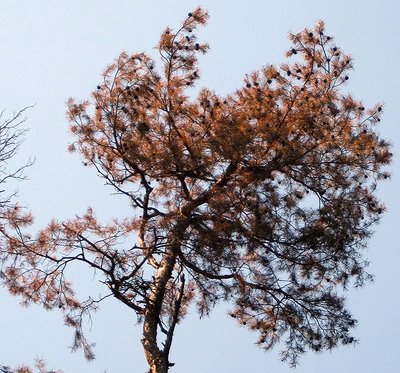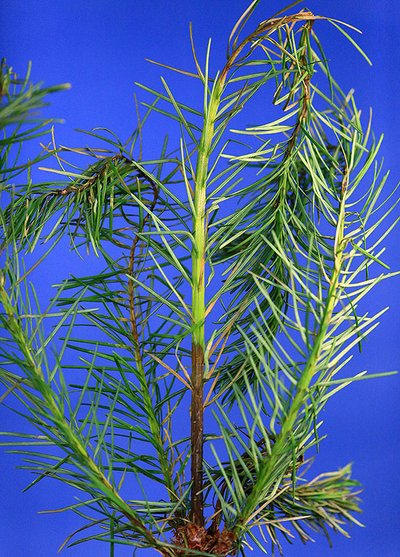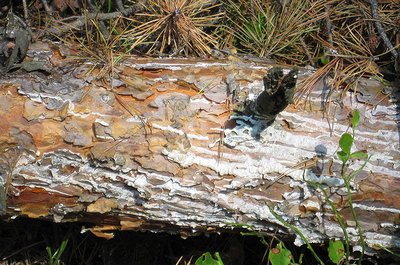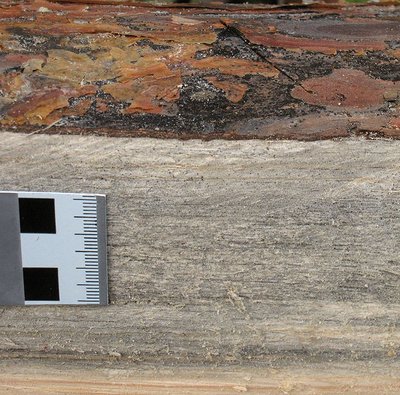Sphaeropsis sapinea used to occur in central Europe especially in the form of a “blue stain” pathogen on sawn timber and as a harmful organism afflicting one to three-year old pine seedlings. The fungus also triggers shoot dieback, however. The occurrence of the species as a pathogen afflicting conifers was first documented after the dry summer of 1947. Diplodia shoot dieback now increasingly affects both Black pine and Scots pine. Recently occurring damage shows only too clearly the potential this disease has to cause damage.
Different organism lifestyles
Shoot dieback is typically linked to previous damage to the tree caused by injuries (often hail damage), insects or drought stress. Sphaeropsis sapinea is thus in the first instance a weak parasite that needs trees with a degree of previous damage or stress in order to switch to its pathogenic lifestyle. The fungus also lives as a saprophyte on dead material or as an asymptomatic endophyte in the plants. The fungus is thus present in the healthy plants and can switch to the pathogenic lifestyle when conditions are favourable to it.
Diplodia shoot dieback benefits from mild winters, warm and humid weather in the spring, and dry summers thereafter. It will thus gain in significance as climate change progresses.
Characteristic symptoms of the disease
Typical symptoms of shoot dieback are brown needles at the tips of shoots (Fig. 1). The needles initially go pale green, and then increasingly turn brown. They remain attached and fall only later. Black fruiting bodies (Pycnidia) form at the base of the needles. If the infestation recurs over several years, the affected twigs and branches become increasingly bald, with the needles only appearing in clumps. Infested shoots become deformed (Fig. 2) and secrete a lot of resin (Fig. 3). This spreads throughout large parts of the crowns in cases of severe infestation.
Fruiting bodies may appear on the bark as well as on the needles. By then, large areas of the timber underneath will be discoloured with bluish streaks (Fig. 4), considerably reducing its value. Two-year old cones are often also infected and serve as an effective source of fungi spores.
Strong infestation eventually leads to the death of the tree - which may even occur within one year. At the same time, the weakened trees are more susceptible to infestation by secondary harmful organisms such as jewel and bark beetles which, depending on their aggressiveness and population dynamics, may cause more extensive damage in their own right.
Disease cycle
The small black fruiting bodies appear on the needles, fascicle sheath, the scales of second year seed cones, and on the bark. The spores are released from (March) April to October - so throughout the entire vegetation period. Initially transparent, the spores later turn brown. Very moist conditions are required for infection; most of the spores are released only in wet weather. The spores need a relatively high level of air humidity in order to germinate and for the hyphae to grow. A particularly critical phase is from April to June, when the new shoots (candles) are developing. Even short periods of wet weather and temperatures above 20° C increase the risk of infection dramatically in this phase. In normal years, the infection risk is relatively low.
Once the fungus has penetrated the needles or the fresh shoots, it quickly destroys the tissues within them. The needles lose colour initially, and then go brown. Affected shoots also show clear signs of necrosis and become stunted or deformed. From the second half of May, the second year cones are infected. Many pycnidia appear on the scales of the cones by the following spring at the latest - and earlier if there is a lot of rain in the late summer.
Host plants
The host plants of Sphaeropsis sapinea include species from the coniferous genera Abies, Cedrus, Chamaecyparis, Cupressus, Juniperus, Larix, Picea, Thuja, Tsuga and Pseudotsuga as well as the 48 different species of pine. The wide range of host plants shows only too clearly the potential this species has to cause damage.
Countermeasures
The fact that the spores are released over the entire vegetation period makes direct measures to combat the fungus very difficult. As a preventive measure, insusceptible or resistant species and provenances should thus be used when establishing the stand. There are significant differences in resistance depending on the provenance. Pines coming from warm, dry regions are least susceptible.
In infected stands, phyto-sanitary measures such as the rigorous removal of badly infected trees (degree of damage >60 % of the needle mass) can be implemented to prevent the mass propagation of secondary harmful organisms. The infection risk can be reduced by opening up dense stands to reduce the air humidity within the stands. Regular thinning measures can reduce competition for water and nutrients among the species and thus the susceptibility of the trees.




